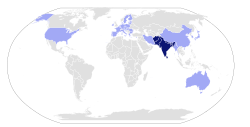South Asian Association for Regional Cooperation
|
South Asian Association
for Regional Cooperation (SAARC)
|
|||||||||||||||||||||
|---|---|---|---|---|---|---|---|---|---|---|---|---|---|---|---|---|---|---|---|---|---|

Logo
|
|||||||||||||||||||||
 |
|||||||||||||||||||||

Member states
Observer states
|
|||||||||||||||||||||
| Headquarters | Kathmandu | ||||||||||||||||||||
| Official languages | English | ||||||||||||||||||||
| Demonym | South Asian | ||||||||||||||||||||
| Member states | |||||||||||||||||||||
| Leaders | |||||||||||||||||||||
| Arjun Bahadur Thapa Directors, Afghanistan, Mr. Maihan Saeedi (Ph.D). Bangladesh, Mr. MJH Jabed. Bhutan, Mr. sangye Rinchhen. India, Dr. Ajay Kumar. Maldives, Ms. Fathimath Najwa. Nepal, Ms. Rita Dhital, Pakistan, Mr. Ali Haider Altaf. Sri Lanka, Mr. M.H.M.N. Bandara | |||||||||||||||||||||
| Establishment | 8 December 1985 | ||||||||||||||||||||
| Area | |||||||||||||||||||||
|
• Total
|
5,099,611 km2 (1,968,971 sq mi) (7th) | ||||||||||||||||||||
|
• Water (%)
|
6.8 | ||||||||||||||||||||
|
• 2015 estimate
|
1,713,870,000 (1st) | ||||||||||||||||||||
|
• Density
|
336.1/km2 (870.5/sq mi) | ||||||||||||||||||||
| GDP (PPP) | 2015 estimate | ||||||||||||||||||||
|
• Total
|
US$9.9 trillion (3rd) | ||||||||||||||||||||
| GDP (nominal) | 2015 estimate | ||||||||||||||||||||
|
• Total
|
US$ 2.9 trillion (5th) | ||||||||||||||||||||
| Currency | |||||||||||||||||||||
| Time zone | (UTC+4:30 to +6) | ||||||||||||||||||||
| Calling code | |||||||||||||||||||||
| Internet TLD | .asia | ||||||||||||||||||||
|
Website
www |
|||||||||||||||||||||
| Bengali: | দক্ষিণ এশীয় আঞ্চলিক সহযোগিতা সংস্থা |
|---|---|
| Dari: |
اتحادیه همکاریهای منطقهای جنوب آسی
|
| Dzongkha: | ༄ ལྷོ ཨེསིཨ་ རེ་གིཨོནལ་ ཅོཨོཔེརཏིཨོན་ ཀོ་མི་ཏི། |
| Hindi: | दक्षिण एशियाई क्षेत्रीय सहयोग संगठन |
| Maldivian: |
ދެކުނު އޭޝިޔާގެ ސަރަޙައްދީ އެއްބާރުލުމުގެ ޖަމިއްޔާ
|
| Nepali: | दक्षिण एशियाली क्षेत्रीय सहयोग सङ्गठन |
| Pashto: |
د سویلي اسیا لپاره د سیمه ایزی همکارۍ ټولنه
|
| Sinhalese: | දකුණු ආසියාතික කලාපීය සහයෝගිතා සංවිධානය |
| Tamil: | தெற்காசிய நாடுகளின் பிராந்தியக் கூட்டமைப்பு |
| Urdu: |
جنوبی ایشیائی علاقائی تعاون کی تنظیم
|
The South Asian Association for Regional Cooperation (SAARC) is the regional intergovernmental organization and geopolitical union of nations in South Asia. Its member states include Afghanistan, Bangladesh, Bhutan, India, Nepal, the Maldives, Pakistan and Sri Lanka. SAARC comprises 3% of the world's area, 21% of the world's population and 3.8% (US$ 2.9 trillion) of the global economy, as of 2015.
SAARC was founded in Dhaka on 8th December,1985. Its secretariat is based in Kathmandu, Nepal. The organization promotes development of economic and regional integration. It launched the South Asian Free Trade Area in 2006. SAARC maintains permanent diplomatic relations at the United Nations as an observer and has developed links with multilateral entities, including the European Union.
The idea of co-operation in South Asia was discussed in at least three conferences: the Asian Relations Conference held in New Delhi on April 1947; the Baguio Conference in the Philippines on May 1950; and the Colombo Powers Conference held in Sri Lanka in April 1954.
In the ending years of the 1970s, the seven inner South Asian nations that included Bangladesh, Bhutan, India, Maldives, Nepal, Pakistan, and Sri Lanka agreed upon the creation of a trade bloc and to provide a platform for the people of South Asia to work together in a spirit of friendship, trust, and understanding. President Ziaur Rahman later addressed official letters to the leaders of the countries of the South Asia, presenting his vision for the future of the region and the compelling arguments for region. During his visit to India in December 1977, Rahman discussed the issue of regional cooperation with the Indian Prime Minister, Morarji Desai. In the inaugural speech to the Colombo Plan Consultative Committee which met in Kathmandu also in 1977, King Birendra of Nepal gave a call for close regional cooperation among South Asian countries in sharing river waters. After the USSR's intervention in Afghanistan, the efforts to established the union was accelerated in 1979 and the resulting rapid deterioration of South Asian security situation. Responding to Rahman and Birendra's convention, the officials of the foreign ministries of the seven countries met for the first time in Colombo in April 1981. The Bangladeshi proposal was promptly endorsed by Nepal, Sri Lanka, Bhutan, and the Maldives but India and Pakistan were sceptical initially. The Indian concern was the proposal’s reference to the security matters in South Asia and feared that Rahman's proposal for a regional organisation might provide an opportunity for new smaller neighbours to renationalise all bilateral issues and to join with each other to form an opposition against India. Pakistan assumed that it might be an Indian strategy to organise the other South Asian countries against Pakistan and ensure a regional market for Indian products, thereby consolidating and further strengthening India’s economic dominance in the region.
...
Wikipedia
